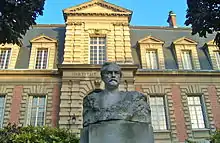15th arrondissement of Paris
The 15th arrondissement of Paris (XVe arrondissement) is one of the 20 arrondissements of the capital city of France. In spoken French, this arrondissement is referred to as quinzième.
15th arrondissement of Paris | |
|---|---|
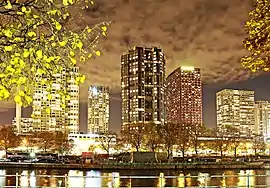 Front de Seine skyline | |
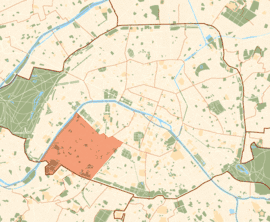 Location within Paris | |
| Coordinates: 48°50′29″N 2°18′01″E | |
| Country | France |
| Region | Île-de-France |
| Department | Paris |
| Commune | Paris |
| Government | |
| • Mayor (2020–2026) | Philippe Goujon (LR) |
| Area | 8.50 km2 (3.28 sq mi) |
| Population | 229,472 |
| • Density | 26,997/km2 (69,920/sq mi) |
| INSEE code | 75115 |
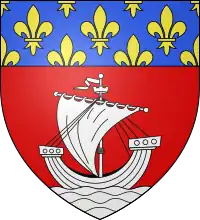 Paris Coat of Arms 20 arrondissements of Paris | |||||||||||||||||||||||||||||||||||||
|---|---|---|---|---|---|---|---|---|---|---|---|---|---|---|---|---|---|---|---|---|---|---|---|---|---|---|---|---|---|---|---|---|---|---|---|---|---|
|
|||||||||||||||||||||||||||||||||||||
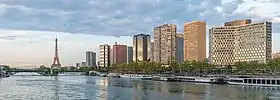
The arrondissement, called Vaugirard, is situated on the left bank of the River Seine. Sharing the Montparnasse district with the 6th and 14th arrondissements, it is the city's most populous arrondissement. The Tour Montparnasse – the tallest skyscraper in Paris – and the neighbouring Gare Montparnasse are both located in the 15th arrondissement, at its border with the 14th. It is also home to the convention centre Paris expo Porte de Versailles and the high-rise district of the Front de Seine (or Beaugrenelle). In 2026, the 180 metres high Tour Triangle will house a 120-room hotel and 70,000 square metres of office space.[2]
History
The loi du 16 juin 1859 decreed the annexation to Paris of the area between the old Wall of the Ferme générale and the wall of Thiers. The communes of Grenelle, Vaugirard, and Javel were incorporated into Paris in 1860.
Charles Michels (b. 1903), was elected Député for the 15th arrondissement by the Popular Front; He was taken hostage and shot by the Nazis in 1941.
Quarters
As in all the Parisian arrondissements, the fifteenth is made up of four administrative quarters (quartiers).

- To the south, quartier Saint-Lambert occupies the former site of the village of Vaugirard, built along an ancient Roman road. The geography of the area was particularly suited to wine-making, as well as quarrying. In fact, many Parisian monuments, such as the École Militaire, were built from Vaugirard stone. The village, not yet being part of Paris, was considered by Parisians to be an agreeable suburb, pleasant for country walks or its cabarets and puppet shows. In 1860 Vaugirard was annexed to Paris, along with adjoining villages. Today, notable attractions in this area include the Parc des Expositions (an exhibition centre which hosts the Foire de Paris, agricultural expositions, and car shows), and Parc Georges-Brassens, a park built on the former site of a slaughterhouse where every year wine by the name of Clos des Morillons is produced and auctioned at the civic centre.
- To the east, quartier Necker was originally an uninhabited space between Paris and Vaugirard. The most well-known landmarks in the area are the Gare Montparnasse train station and the looming Tour Montparnasse office tower. The area around the train station has been renovated and now contains a number of office and apartment blocks, a park (the Jardin Atlantique, built directly over the train tracks), and a shopping centre. Finally, the quartier contains a number of public buildings: the Lycée Buffon, the Necker Children's Hospital, as well as the private foundation Pasteur Institute.
- To the north, quartier Grenelle was originally a village of the same name. Grenelle plain extended from the current Hôtel des Invalides to the suburb of Issy-les-Moulineaux on the other side of the Seine, but remained mostly uninhabited in centuries past due to difficulties farming the land. At the beginning of the 19th century, an entrepreneur by the name of Violet divided off a section of the plain: this became the village of Beaugrenelle, known for its series of straight streets and blocks, which remain today. The whole area broke off from the commune of Vaugirard in 1830, becoming the commune of Grenelle, which was in turn annexed to Paris in 1860. A century later, a number of apartment and office towers were built along the Seine, the Front de Seine along with the Beaugrenelle shopping mall.
- To the west, quartier Javel lies to the south of Grenelle plain. In years past, it was the industrial area of the arrondissement: first with chemical companies (the famous Eau de Javel [bleach] was invented and produced there), then electrical companies (Thomson), and finally car manufacturers (Citroën), whose factories occupied a large part of the quartier up until the early 1970s. The industrial areas have since been rehabilitated, and the neighbourhood now contains Parc André Citroën, Georges Pompidou European Hospital, and a number of large office buildings and television studios (Sagem, Snecma, the Direction Générale de l'Aviation Civile, Canal Plus, France Télévisions, etc.). In addition, to the south of the circular highway (boulevard périphérique), an extension of the 15th, formerly an aerodrome at the beginning of the 20th century, is now a heliport, a gym and a recreation centre.
The early airfield here has been encroached upon by urban development and a sports centre, but the residual area, mainly laid to grass, continues to serve Paris as a heliport. The Sécurité Civile has a detachment there close to maintenance facilities. Customs facilities are available and especially busy during the Salon d'Aeronautique airshows held at Le Bourget on the other side of the city.
Geography
The 15th arrondissement is located in the south-western part of Paris, on the left bank of the Seine. It includes one of the three islands in Paris, the Île aux Cygnes.
At 8.5 km2 (3.28 sq. miles, or 2,100 acres), it is the third largest arrondissement in Paris, and would be the largest if the large parks Bois de Boulogne and Bois de Vincennes were not counted as part of the 16th and 12th arrondissements.
Demography
The peak of population of Paris's 15th arrondissement occurred in 1962, when it had 250,551 inhabitants. Since then it has lost approximately one-tenth of its population, but it remains the most populous arrondissement of Paris, with 225,362 inhabitants at the last census in 1999. With 144,667 jobs at the same census, the 15th is also very dense in business activities. This arrondissement is home to many families and is known in Paris as one of the quietest sections in Paris. The majority of the arrondissement is relatively unfrequented by tourists, a rarity for one of the world's most visited cities.
.JPG.webp) Paris – Pont Mirabeau detail
Paris – Pont Mirabeau detail Colonnes d'eau Parc Andre Citroen Paris
Colonnes d'eau Parc Andre Citroen Paris Paris XV, rue Alain Chartier, Wallace fountain
Paris XV, rue Alain Chartier, Wallace fountain Statue of Liberty (with Eiffel Tower in background)
Statue of Liberty (with Eiffel Tower in background)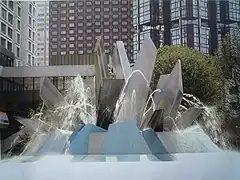 Cristaux. Jean-Yves Lechevallier
Cristaux. Jean-Yves Lechevallier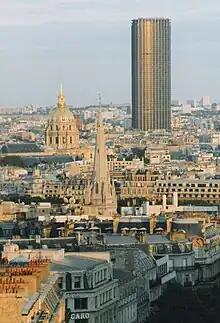

Historical population
| Year (of French censuses) |
Population | Density (inh. per km2) |
|---|---|---|
| 1872 | 75,449 | 8,874 |
| 1954 | 250,124 | 29,419 |
| 1962 (peak of population) | 250,551 | 29,470 |
| 1968 | 244,080 | 28,709 |
| 1975 | 231,301 | 27,205 |
| 1982 | 225,596 | 26,534 |
| 1990 | 223,940 | 26,340 |
| 1999 | 225,362 | 26,507 |
| 2009 | 236,491 | 27,888 |
Immigration
| Born in metropolitan France | Born outside metropolitan France | |||
|---|---|---|---|---|
| 80.0% | 20.0% | |||
| Born in overseas France |
Born in foreign countries with French citizenship at birth1 | EU-15 immigrants2 | Non-EU-15 immigrants | |
| 1.0% | 4.8% | 4.0% | 10.2% | |
| 1 This group is made up largely of former French settlers, such as Pieds-Noirs in Northwest Africa, followed by former colonial citizens who had French citizenship at birth (such as was often the case for the native elite in French colonies), as well as to a lesser extent foreign-born children of French expatriates. A foreign country is understood as a country not part of France in 1999, so a person born for example in 1950 in Algeria, when Algeria was an integral part of France, is nonetheless listed as a person born in a foreign country in French statistics. 2 An immigrant is a person born in a foreign country not having French citizenship at birth. An immigrant may have acquired French citizenship since moving to France, but is still considered an immigrant in French statistics. On the other hand, persons born in France with foreign citizenship (the children of immigrants) are not listed as immigrants. | ||||
Places of interest
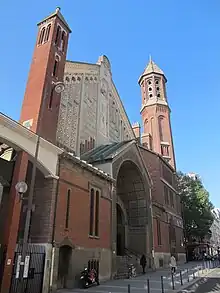
 Keller Swimming pool
Keller Swimming pool Citroën models
Citroën models Panoramic restaurant
Panoramic restaurant Péniche Thalassa, Quai André-Citroën
Péniche Thalassa, Quai André-Citroën

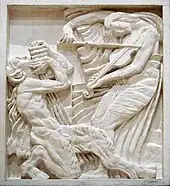
- Grand Pavois de Paris (1971), one of the largest real estate complexes in Paris
- Musée Pasteur[3]
- Musée du Service des Objets Trouvés
- Musée Bourdelle
- Musée Mendjisky, specializing in school of Paris artists, housed in a Robert Mallet-Stevens building.[4]
- Musée Jean Moulin, French Resistance – (musées Leclerc-Moulin)[5]
- Church of Notre-Dame de la Salette in Paris
- Beaugrenelle Shopping Centre[6]
- Parts of the Montparnasse area.
- The former workshop (no longer standing) of Constantin Brâncuși, where the sculptor worked from 1925 to 1957 has now been relocated in front of the Centre Georges Pompidou
- Villa Santos Dumont where Ossip Zadkine and Fernand Léger[7] had their workshop, also featured in Gail Albert Halaban book Out of my Window, Paris.[8]
- La Ruche
- Square Béla Bartók where the sculpture-fountain Cristaux by Jean-Yves Lechevallier can be seen.
- Square de l'Oiseau-Lunaire, featuring a sculpture by Juan Miro (the L'Oiseau Lunaire) with a plaque commemorating the many artists, poets and painters or sculptors who lived there, including André Masson, Jean Dubuffet, Antonin Artaud and Robert Desnos.
- A replica of the statue of Liberty on the île aux Cygnes where Bartholdi worked.
- The Pont de Bir-Hakeim
- The Pont Mirabeau
- The Parc André Citroën with the Ballon de Paris.[9]
- The Parc Georges-Brassens
- The Polypores Fountain by Jean-Yves Lechevallier featured in the movie by Alain Resnais Same Old Song.
- Paris expo Porte de Versailles exhibition centre (with the Tour Triangle project) and Palais des Sports, near Porte de Versailles metro station.
- Front de Seine high-rise district.
- Cheminée du Front de Seine is a 130 m (430 ft) chimney that is the 4th tallest structure in Paris
Government and infrastructure
- At one time the head office of the Bureau Enquêtes-Accidents was in the 15th arrondissement.[10]
- Since November 2015 the French Ministère des Armées ("Ministry of the Armed Forces") has been located in purpose-built building near the Balard Métro station.[11]
- Australian Embassy
- Japanese Cultural Centre in Paris[12]
- Institut Français[13]
Economy
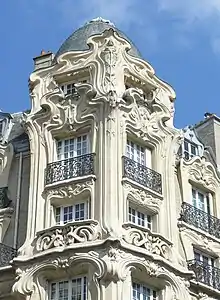
- The headquarters of Orange S.A. and Eutelsat are located in the 15th arrondissement.[14]
- La Poste, the French mail service, has its head office in the arrondissement.[15][16]
- The publisher Hachette Livre also has its headquarters in the arrondissement.[17]
- Prior to the completion of the current Air France headquarters in Tremblay-en-France in December 1995,[18][19] Air France was headquartered in a tower located next to the Gare Montparnasse rail station in Montparnasse and in the 15th arrondissement; Air France had its headquarters in the tower for about 30 years.[20][21][22]
- Previously the Tour Maine-Montparnasse, in the 15th arrondissement of Paris housed the executive management of Accor.[23]
- Journal officiel de la République française
- French Football Federation
- Conseil supérieur de l'audiovisuel
- Safran
- Institut français des relations internationales
- European Space Agency
- International Energy Agency
- Eutelsat
- France Télévisions
- International Council of Museums
- Hôpital Européen Georges-Pompidou
 Palais des Sports de Paris
Palais des Sports de Paris Marché rue de la Convention
Marché rue de la Convention Ile des Cygnes and St Christophe Church
Ile des Cygnes and St Christophe Church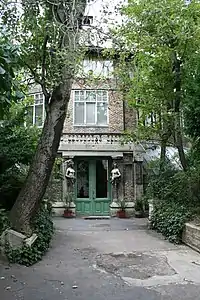 Entrance to "La Ruche"
Entrance to "La Ruche"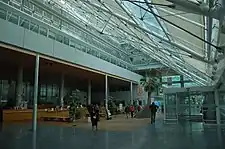 European Hospital Georges-Pompidou, Hall
European Hospital Georges-Pompidou, Hall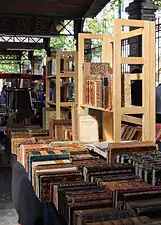 Marché du livre ancien Georges Brassens
Marché du livre ancien Georges Brassens Ballon air de Paris
Ballon air de Paris
Education and research
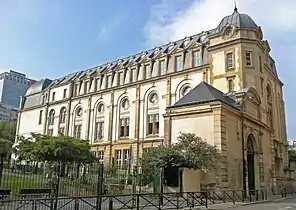
- Schiller International University has a campus in the arrondissement. It is in proximity to Place de la Convention.[24]
- The arrondissement is also host to the École Active Bilingue Jeannine Manuel international school and the international bilingual school, Victor Hugo, (école internationale bilingue)[25]
- International Culinary school Le Cordon Bleu, established in 1895, has a campus in the 15th (rue Léon Delhomme)[26]
- Necker-Enfants Malades Hospital affiliated to the University of Paris Descartes, (pediatrics)
- Pantheon-Sorbonne University, Saint Charles Campus - Visual arts and aesthetics.[27]
- Panthéon-Assas University, Campus Vaugirard, Law school
- PariSanté Campus
- Pasteur Institute
- Laboratoire de Phonétique et Phonologie
Notable people
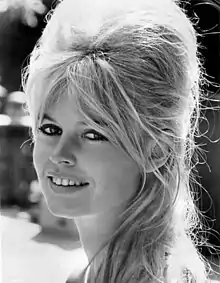
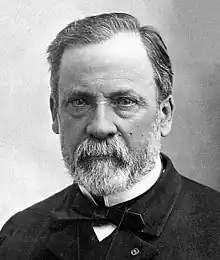
- Brigitte Bardot, actress
- Samuel Beckett, writer, who lived in the 15th arrondissement for most of his adult life
- Walter Benjamin, philosopher
- Luc Besson, filmmaker
- Antoine Bourdelle, artist
- Alexander Calder, artist
- Marc Chagall, artist
- Barbara Chase-Riboud, artist
- Dietrich von Choltitz, military governor of Paris, 1944–1945
- André Citroën, industrialist
- Robert Desnos, poet and member of the French Resistance
- Michel Foucault, philosopher
- Tsuguharu Foujita, artist
- François Hollande, President of France (2012–2017)
- René Magritte, artist
- Sophie Marceau, actress
- André Masson, artist
- Henry Miller, writer, lived in the 15th where he worked on Tropic of Cancer.[28]
- Joan Miró, artist
- Jacques Monod and Francois Jacob discovered the mechanism of genes' transcription regulation, a work honored by the 1965 Nobel Prize in Physiology or Medicine.
- Luc Montagnier, Françoise Barré-Sinoussi and colleagues discovered the two HIV viruses that cause AIDS, in 1983 and 1985, were honored by the 2008 Nobel Prize in Physiology or Medicine.
- Louis Pasteur, microbiologist
- Marie-Claire Pauwels, journalist
- Ossip Zadkine, artist
- Nekfeu, hip-hop artist
See also
References
- "Populations légales 2020". The National Institute of Statistics and Economic Studies. 29 December 2022.
- "Porte de Versailles Exhibition Centre". Paris Digest. 2018. Retrieved 2018-11-10.
- "Pasteur Museum". Institut Pasteur. Retrieved 11 August 2017.
- Leroy, Christophe. "Musée Mendjisky-Ecoles de Paris". FMEP (in French). Retrieved 11 August 2017.
- "Musée du Général Leclerc et de la Libération de Paris – Musée Jean Moulin". Musées Leclerc Moulin (in French). Retrieved 11 August 2017.
- "Beaugrenelle". beaugrenelle-paris.com. Retrieved 11 August 2017.
- "Rue et villa Santos-Dumont". Gavroche père & fils (in French). 18 November 2010. Archived from the original on 11 August 2017. Retrieved 11 August 2017.
- "Villa Santos-Dumont, 15th arrondissement, Paris, 2013". Aperture.org. Retrieved 11 August 2017.
- "Ballon Generali". Paris Tourist Office. Retrieved 11 August 2017.
- "Accident Report, 17 March 1982" (PDF). Bureau Enquêtes-Accidents (in French). Archived (PDF) from the original on 21 February 2014. Retrieved 18 April 2012.
246, rue Lecourbe 75732 PARIS – France.
- Hohenadel, Kristin (13 November 2015). "France's New Defense Building, Inspired by the Pentagon, Is...a Hexagon". Slate. Retrieved 11 August 2017.
- "Mentions legales". Maison de la culture du Japon à Paris (in French). Retrieved 11 August 2017.
101 bis, quai Branly, 75015 Paris.
- "Contact". Institut Français (in French). Retrieved 11 August 2017.
- "Legal Matters". Orange. Retrieved 6 October 2009.
- "Contact Us". La Poste. Archived from the original on 13 January 2014. Retrieved 22 December 2010.
La Poste laposte.com V603 44 bd de Vaugirard 75015 Paris – France.
- "Mentions légales". La Poste (in French). Archived from the original on 2 January 2011. Retrieved 22 December 2010.
Siège social ("Headquarters") : 44 boulevard de Vaugirard – 75757 PARIS CEDEX 15.
- "Home". Hachette Livre. Retrieved 17 April 2011.
Hachette Livre 43, quai de Grenelle 75905 Paris Cedex 15.
- "Air France Head Quarters – Roissypole" (PDF). Groupement d'Etudes et de Méthodes d'Ordonnancement (GEMO) (in French). Archived from the original (PDF) on 11 July 2011. Retrieved 20 September 2009.
- "Roissy Charles-de-Gaulle". Tremblay-en-France (in French). Archived from the original on 13 October 2010. Retrieved 20 September 2009.
- Salpukas, Agis (27 December 1992). "Air France's Big Challenge". The New York Times. Archived from the original on 18 June 2009. Retrieved 13 May 2009.
- "World Airline Directory". Flight International. Vol. 108, no. 3445. 20 March 1975. p. 466.
- Mlekuz, Nathalie (2 April 1997). "Air France vole vers ses avions, destination Roissy". Le Monde (in French). Retrieved 22 September 2009.
- "Address book". Accor. Archived from the original on 17 October 2006. Retrieved 19 March 2012.
Executive Management Tour Maine-Montparnasse 33, avenue du Maine 75755 Paris Cedex 15 France.
- "Schiller Paris". Schiller International University. Retrieved 28 August 2011.
Schiller International University 9, rue Yvart 75015 – Paris FRANCE.
- "EIB Victor Hugo School". EIB Paris. Retrieved 11 August 2017.
- "Why this culinary arts and hospitality management school?". Le Cordon Bleu Paris. Retrieved 11 August 2017.
- "Visual arts and aesthetics" (PDF). Pantheon-Sorbonne University. Retrieved 11 August 2017.
- "Henry Miller & Richard Galen Osborn's apartment". PBase. Retrieved 11 August 2017.
Bibliography
- Vallois, Thirza (1999). Around and About Paris: Vol.3: New Horizons: Haussmann's Annexation (Arrondissements 13–20). Iliad Books. pp. 80–104. ISBN 978-0-9525378-2-3. Retrieved 29 April 2015.
- Pringle-Harris, Ann (2 November 1997). "The 15th, a World of Its Own". The New York Times. Retrieved 7 April 2015.
External links
 15th arrondissement travel guide from Wikivoyage
15th arrondissement travel guide from Wikivoyage
